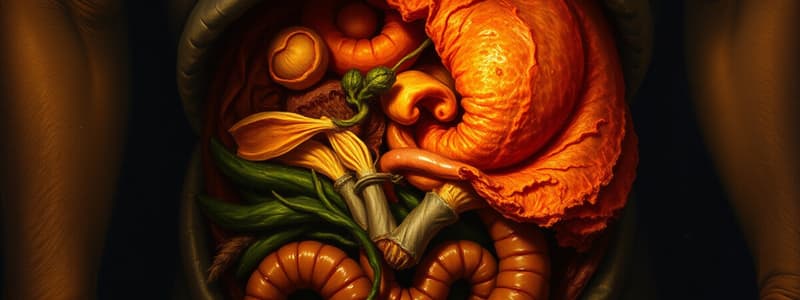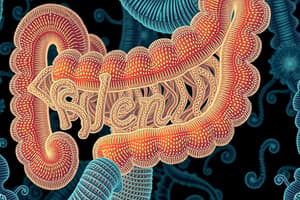Podcast
Questions and Answers
Which enzyme acts on fats and is produced in the pancreas?
Which enzyme acts on fats and is produced in the pancreas?
- Lipase (correct)
- Protease
- Bile salts
- Amylase
Bile salts are produced in the stomach.
Bile salts are produced in the stomach.
False (B)
What is the primary function of the ileum in the digestive system?
What is the primary function of the ileum in the digestive system?
Absorption of digested foodstuffs
The enzyme that breaks down proteins in the stomach is called ______.
The enzyme that breaks down proteins in the stomach is called ______.
Match the following digestive enzymes with their corresponding action sites:
Match the following digestive enzymes with their corresponding action sites:
What is the primary function of the hepatic portal vein?
What is the primary function of the hepatic portal vein?
The large intestine plays no role in nutrient absorption.
The large intestine plays no role in nutrient absorption.
What do symbiotic bacteria in the intestine primarily produce for the human body?
What do symbiotic bacteria in the intestine primarily produce for the human body?
The last part of the large intestine where feces are stored is called the ______.
The last part of the large intestine where feces are stored is called the ______.
Match the following sections of the large intestine with their functions:
Match the following sections of the large intestine with their functions:
What role does dietary fiber play in digestion?
What role does dietary fiber play in digestion?
What structures in the ileum enhance absorption by increasing surface area?
What structures in the ileum enhance absorption by increasing surface area?
What is one of the primary roles of saliva during digestion?
What is one of the primary roles of saliva during digestion?
The main enzyme found in saliva is pepsin.
The main enzyme found in saliva is pepsin.
What protects the stomach lining from acid and digestive enzymes?
What protects the stomach lining from acid and digestive enzymes?
The _______ sphincter controls the movement of chyme from the stomach to the duodenum.
The _______ sphincter controls the movement of chyme from the stomach to the duodenum.
Match the following stomach functions with their descriptions:
Match the following stomach functions with their descriptions:
Which part of the small intestine is responsible for the majority of absorption?
Which part of the small intestine is responsible for the majority of absorption?
Peristalsis is the process that moves food from the mouth to the stomach.
Peristalsis is the process that moves food from the mouth to the stomach.
How long is the small intestine?
How long is the small intestine?
Saliva contains an enzyme called _______ that begins the digestion of carbohydrates.
Saliva contains an enzyme called _______ that begins the digestion of carbohydrates.
What is the primary function of pancreatic enzymes in digestion?
What is the primary function of pancreatic enzymes in digestion?
Flashcards are hidden until you start studying
Study Notes
Hepatic Portal Vein and Nutrient Absorption
- Hepatic portal vein transports absorbed nutrients from the digestive tract to the liver.
- Fatty acids, glycerol, cholesterol, and fat-soluble vitamins enter lacteals and are carried through the lymphatic system, eventually reaching the circulatory system via the subclavian vein.
Adaptations of the Ileum for Absorption
- The ileum is a long tube featuring numerous villi and microvilli, maximizing the surface area for nutrient absorption.
- The thin walls of villi facilitate rapid movement of substances.
- A rich network of blood capillaries in the villi transports soluble nutrients directly to the liver.
- Lymphatic capillaries in villi are responsible for removing fat.
Main Sections of the Large Intestine
- Caecum: Involved in absorbing water and salts.
- Appendix: Serves as a reservoir for beneficial bacteria.
- Colon: Absorbs additional water, salts, and some nutrients; prepares waste (stool) for elimination.
- Rectum: Stores faeces before elimination through peristalsis.
- Anus: Contains a sphincter muscle that controls fecal retention and expulsion.
Role of Symbiotic Bacteria
- Produce vitamins B and K, which are absorbed through the large intestine.
- Outcompete pathogenic bacteria, preventing their establishment in the intestine.
Importance of Dietary Fibre
- Fibre is indigestible material, mainly from plants; it can be soluble or insoluble.
- A high-fibre diet helps prevent constipation by retaining water, making faeces soft and easy to pass.
Functions of Saliva
- Moistens food and dissolves soluble components.
- Softens food to reduce injury risk to the oesophagus and stomach during swallowing.
- Acts as a lubricant for easier passage of the food bolus through the oesophagus.
- Contains amylase, initiating carbohydrate digestion.
Structure and Function of the Oesophagus
- Composed of smooth muscle, it transports food from the mouth to the stomach.
- Food movement is facilitated by peristalsis, a series of muscular contractions.
Anatomy and Functions of the Stomach
- The cardiac sphincter opens to allow food entry, then seals to keep food inside.
- Gastric pits secrete hydrochloric acid, which kills bacteria and activates pepsinogen to pepsin for protein digestion.
- Mucus produced in the stomach wall protects it from acid and enzymes, preventing ulcers.
- The pyloric sphincter regulates the entry of chyme into the duodenum.
Structure and Role of the Small Intestine
- Composed of three sections: duodenum, jejunum, and ileum; approximately six metres long.
- Folded structure increases surface area; exocrine glands secrete bile into the duodenum for fat emulsification.
Digestive Enzymes Overview
- Amylase: Breaks down starch into maltose in the mouth and small intestine, functions optimally at pH 7-10.
- Protease: Degrades proteins into polypeptides in the stomach and small intestine, active at pH 1-10.
- Bile Salts: Emulsify fats in the duodenum, with an optimal pH of 10.
- Lipase: Breaks down fats into fatty acids and glycerol in the small intestine, optimal at pH 10.
Absorption in the Ileum
- Primary site for the absorption of glucose, amino acids, water-soluble vitamins, and minerals.
- Nutrients absorbed via diffusion and active transport into blood capillaries.
Studying That Suits You
Use AI to generate personalized quizzes and flashcards to suit your learning preferences.




